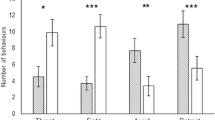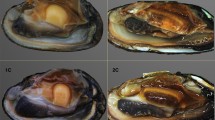Abstract
Symbiont spillover involves the emergence of new interactions that can influence both the symbiont and the host invasion processes. Here we aimed at experimentally testing the transmission of an exotic ectosymbiont, Ankylocythere sinuosa (Ostracoda, Entocytheridae), from a crayfish invader (Procambarus clarkii) to a native European crayfish (Austropotamobius italicus). Crayfish transmitter and receiver were placed in the same container during 4 days. Three experimental treatments were designed: (i) crayfish transmitter alone (i.e. control group); (ii) cleaned P. clarkii as crayfish receiver; (iii) A. italicus as crayfish receiver. The proportions of colonised crayfish were 92% for P. clarkii and 100% for A. italicus. Mean symbiont emission rate of the control group was 2.75%, with 2.5 times odds increase under the presence of crayfish receiver. Mean transmission rate in treatments with P. clarkii receivers was 38.48%, with higher odds to bigger crayfish receivers (5% increase per gram) and to A. italicus (2.1 times). All entocytherid growth stages were transmitted. We demonstrated that entocytherids harbour transmission features that allow them to achieve successful spillover in nature. However, the symbiont was not found on native crayfish in nature hitherto, probably due to host competitive exclusion and crayfish plague acting on native hosts.


Similar content being viewed by others
References
Aguilar-Alberola, J. A., F. Mesquita-Joanes, S. López, A. Mestre, J. C. Casanova, J. Rueda & A. Ribas, 2012. An invaded invader: high prevalence of entocytherid ostracods on the red swamp crayfish Procambarus clarkii (Girard, 1852) in the Eastern Iberian Peninsula. Hydrobiologia 688: 63–73.
Almberg, E. S., P. C. Cross, A. P. Dobson, D. W. Smith & P. J. Hudson, 2012. Parasite invasion following host reintroduction: a case study of Yellowstone’s wolves. Philosophical Transactions of the Royal Society B 367: 2840–2851.
Baker, J. H., 1969. On the relationship of Ankylocythere sinuosa (Rioja 1942) (Ostracoda, Entocytheridae) to the crayfish Procambarus simulans simulans (Faxon 1884). Transactions of the American Microscopical Society 88: 293–294.
Barton, D., 1997. Introduced animals and their parasites: the cane toad, Buffo marinus, in Australia. Australian Journal of Ecology 22: 316–324.
Blanco, G. & O. Frías, 2001. Symbiotic feather mites synchronize dispersal and population growth with host sociality and migratory disposition. Ecography 24: 113–120.
Castillo-Escrivà, A., A. Mestre, J. S. Monrós & F. Mesquita-Joanes, 2013. Population dynamics of an epibiont Ostracoda on the invasive red swamp crayfish Procambarus clarkii in a western Mediterranean wetland. Hydrobiologia 714: 217–228.
Cuéllar, M. C., I. García-Cuenca & J. C. Fontanillas, 2002. Description de la zooépibiose de l’ecrevisse signal (Pacifastacus leniusculus, Dana) en astaciculture. Bulletin Français de la Pêche et de la Pisciculture 367: 959–972.
Danielopol, D. L., 1985. Notes on the center of origin and on the antiquity of the Sphaeromicolinae, with description of Hobbsiella, new genus (Ostracoda, Entocytheridae). Stygologia 1: 54–70.
Hart, D. G. & C. W. Jr Hart, 1974. The Ostracod Family Entocytheridae, 1st ed. Fulton Press Inc., Lancaster.
Hiley, P. D., 2003. The slow quiet invasion of signal crayfish (Pacifastacus leniusculus) in England – prospects for the white-clawed crayfish (Austropotamobius pallipes). In Holdich, D. M. & P. J. Sibley (eds), Management and Conservation of Crayfish. Proceedings of a Conference Held on 7th November, 2002. Environment Agency, Bristol: 127–138.
Holdich, D. M., 2002. Distribution of crayfish in Europe and some adjoining countries. Bulletin Français de la Pêche et de la Pisciculture 367: 611–650.
Holdich, D. M., 2003. Crayfish in Europe – An overview of taxonomy, legislation, distribution, and crayfish plague outbrakes. In Holdich, D. M. & P. J. Sibley (eds), Management and Conservation of Crayfish. Proceedings of a Conference Held on 7th November, 2002. Environment Agency, Bristol: 15–34.
Hubault, É., 1938. Sphaeromicola sphaeromidicola, nov. sp. commensal de Sphaeromides virei Valle, en Istrie et considérations sur l’origine de diverses espècies cavernicoles périméditerranéennes. Archives de Zoologie Experimentale et Generale 80: 11–24.
Hudson, P. & J. Greenman, 1998. Competition mediated by parasites: biological and theoretical progress. Trends in Ecology & Evolution 13: 387–390.
Jones, T. C. & R. J. G. Lester, 1996. Factors influencing populations of the ectosymbiont Diceratocephala boschmai (Platyhelminthes: Temnocephalida), on the redclaw crayfish Cherax quadricarinatus maintained under laboratory conditions. Aquaculture 143: 233–243.
Kelehear, C., G. P. Brown & R. Shine, 2013. Invasive parasites in multiple invasive hosts: the arrival of a new host revives a stalled prior parasite invasion. Oikos 122: 1317–1324.
Kouba, A., A. Petrusek & P. Kozák, 2014. Continental-wide distribution of crayfish species in Europe: update and maps. Knowledge and Management of Aquatic Ecosystems 413: 05.
Lello, J., B. Boag, A. Fenton, I. A. Stevenson & P. J. Hudson, 2004. Competition and mutualism among the gut helminths of a mammalian host. Nature 428: 840–844.
Leung, T. L. F. & R. Poulin, 2008. Parasitism, commensalism, and mutualism: exploring the many shades of symbioses. Vie et Milieu – Life and Environment 58: 107–115.
Lymbery, A. J., M. Morine, H. G. Kanani, S. J. Beatty & D. L. Morgan, 2014. Co-invaders: the effects of alien parasites on native hosts. International Journal for Parasitology 3: 171–177.
Mastitsky, S. E., A. Y. Karatayev, L. E. Burlakova & D. P. Molloy, 2010. Parasites of exotic species in invaded areas: does lower diversity mean lower epizootic impact? Diversity and Distributions 16: 798–803.
Matthee, S. & B. R. Krasnov, 2009. Searching for generality in the patterns of parasite abundance and distribution: ectoparasites of a South African rodent, Rhabdomys pumilio. International Journal for Parasitology 39: 781–788.
Mckenzie, K. G., 1973. The biogeography of some cainozoic ostracoda. Special Papers in Palaeontology 12: 137–153.
Mestre, A., J. S. Monrós & F. Mesquita-Joanes, 2011. Comparison of two chemicals for removing an entocytherid (Ostracoda: Crustacea) species from its host crayfish (Cambaridae: Crustacea). International Review of Hydrobiology 96: 347–355.
Mestre, A., J. A. Aguilar-Alberola, D. Baldry, H. Balkis, A. Ellis, J. A. Gil-Delgado, K. Grabow, G. Klobučar, A. Kouba, I. Maguire, A. Martens, A. Mülayim, J. Rueda, B. Scharf, M. Soes, J. S. Monrós & F. Mesquita-Joanes, 2013. Invasion biology in non-free-living species: interactions between abiotic (climatic) and biotic (host availability) factors in geographical space in crayfish commensals (Ostracoda, Entocytheridae). Ecology and Evolution 3: 5237–5253.
Mestre, A., J. S. Monrós & F. Mesquita-Joanes, 2014a. A review of the Entocytheridae (Ostracoda) of the world: updated bibliographic and species checklists and global georeferenced database, with insights into host specificity and latitudinal patterns of species richness. Crustaceana 87: 923–951.
Mestre, A., J. S. Monrós & F. Mesquita-Joanes, 2014b. The influence of environmental factors on abundance and prevalence of a commensal ostracod hosted by an invasive crayfish: are ‘parasite rules’ relevant to non-parasitic symbionts? Freshwater Biology 59: 2107–2121.
Mordecai, E. A., 2013. Consequences of pathogen spillover for cheatgrass-invaded grasslands: coexistence, competitive exclusion, or priority effects. The American Naturalist 181: 737–747.
Mori, M., Y. Pretoni, S. Salvidio & A. Balduzzi, 2001. Branchiobdellid size-crayfish size: a possible relationship. Journal of Limnology 60: 208–210.
Paterson, R. A., C. A. Rauque, M. V. Fernandez, C. R. Townsend, R. Poulin & D. M. Tompkins, 2013. Native fish avoid parasite spillback from multiple exotic hosts: consequences of host density and parasite competency. Biological Invasions 15: 2205–2218.
Poulin, R., 2007. Evolutionary Ecology of Parasites, 2nd ed. Princeton University Press, New Jersey.
Poulin, R., 2013. Explaining variability in parasite aggregation levels among host samples. Parasitology 140: 541–546.
Power, A. G. & C. E. Mitchell, 2004. Pathogen spillover in disease epidemics. The American Naturalist 164: S79–S89.
Prenter, J., C. MacNeil, J. T. A. Dick & A. M. Dunn, 2004. Roles of parasites in animal invasions. Trends in Ecology & Evolution 19: 385–390.
R Core Team, 2013. R: A language and environment for statistical computing. R Foundation for Statistical Computing, Vienna, Austria.
Rodríguez-Echeverría, S., S. Fajardo, B. Ruiz-Díez & M. Fernández-Pascual, 2012. Differential effectiveness of novel and old legume-rhizobia mutualisms: implications for invasion by exotic legumes. Oecologia 170: 253–261.
Roy, H. E. & L. J. L. Handley, 2012. Networking: a community approach to invaders and their parasites. Functional Ecology 26: 1238–1248.
Skelton, J., K. J. Farrell, R. P. Creed, B. W. Williams, C. Ames, B. S. Helms, J. Stoekel & B. L. Brown, 2013. Servants, scoundrels, and hitchhikers: current understanding of the complex interactions between crayfish and their ectosymbiotic worms (Branchiobdellida). Freshwater Science 32: 1345–1357.
Smith, R. J. & T. Kamiya, 2005. The ontogeny of the entocytherid ostracod Uncinocythere occidentalis (Kozloff and Whitman, 1954) Hart, 1962 (Crustacea). Hydrobiologia 538: 217–229.
Stanko, M., B. R. Krasnov & S. Morand, 2006. Relationship between host abundance and parasite distribution: inferring regulating mechanisms from census data. Journal of Animal Ecology 75: 575–583.
Strauss, A., A. White & M. Boots, 2012. Invading with biological weapons: the importance of disease-mediated invasions. Functional Ecology 26: 1249–1261.
Taraschewski, H., 2006. Hosts and parasites as aliens. Journal of Helminthology 80: 99–128.
Taraschewski, H., J. Boomker, K. Knopf & F. Moravec, 2005. Anguillicola papernai (Nematoda: Anguillicolidae) and other helminths parasitizing the African longfin eel Anguilla mossambica. Diseases of Aquatic Organisms 63: 185–195.
Taylor, C. A., 2002. Taxonomy and conservation of native crayfish stocks. In Holdich, D. M. (ed.), Biology of Freshwater Crayfish. Blackwell Science, Oxford: 236–257.
Telfer, S. & K. Bown, 2012. The effects of invasion on parasite dynamics and communities. Functional Ecology 26: 1288–1299.
Tompkins, D. M., A. M. Dunn, M. J. Smith & S. Telfer, 2011. Wildlife diseases: from individuals to ecosystems. Journal of Animal Ecology 80: 19–38.
Torchin, M. E., K. D. Lafferty, A. P. Dobson, V. J. McKenzie & A. M. Kuris, 2003. Introduced species and their missing parasites. Nature 421: 628–630.
Vedia, I., J. Oscoz, J. Rueda, R. Miranda, E. M. Garcia-Roger, E. Baquero & E. A. Gelder, 2014. An alien ectosymbiotic branchiobdellidan (Annelida: Clitellata) adopting exotic crayfish: a biological co-invasion with unpredictable consequences. Inland Waters 5: 89–92.
Venables, W. N. & B. D. Ripley, 2002. Modern Applied Statistics with S. Springer, New York.
Vignon, M., P. Sasal, M. C. Rigby & R. Galzin, 2009. Multiple parasite introduction and host management plan: case study of lutjanid fish in the Hawaiian Archipelago. Diseases of Aquatic Organisms 85: 133–145.
Young, W., 1971. Ecological studies of Entocytheridae (Ostracoda). American Midland Naturalist 85: 399–409.
Acknowledgements
We thank Pilar Ore, Gregorio Herrera, J. A. Gil-Delgado and the astaciculture center of Río de Gallo (Guadalajara, Spain) for their help in supply and transport of native crayfish specimens for the experiment; the governments of Castilla-La Mancha and Generalitat Valenciana provided us the permissions to manage native crayfish for this work; we want to thank Lucas Cabrera and Silvia Piñeiro for their technical support and Romina Liberto for her help during the experiment; the experiments were carried out in the Aquarium Plant of the Central Service for Experimental Research (SCSIE, University of Valencia). This research was funded by the Spanish Ministry of Science and Innovation Project ECOINVADER (CGL2008-01296/BOS) and the University of Valencia (“V-Segles” predoctoral grant to A. Mestre). Finally, we thank the handling editor Diego Fontaneto and two anonymous reviewers for their contribution to improve the quality of this work.
Author information
Authors and Affiliations
Corresponding author
Additional information
Handling editor: Diego Fontaneto
Electronic supplementary material
Below is the link to the electronic supplementary material.
Rights and permissions
About this article
Cite this article
Mestre, A., Castillo-Escrivà, A., Rueda, J. et al. Experimental spillover of an exotic ectosymbiont on an European native crayfish: the importance of having a chance. Hydrobiologia 755, 225–237 (2015). https://doi.org/10.1007/s10750-015-2236-y
Received:
Revised:
Accepted:
Published:
Issue Date:
DOI: https://doi.org/10.1007/s10750-015-2236-y




